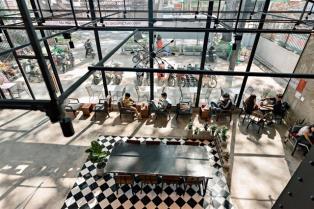The recent rice export contracts won by some companies forced rice prices up in late July and made the market in the Cuu Long (Mekong) Delta very busy to farmers' delight.
 |
| According to figures from the Viet Nam Food Association (VFA), in 2014 exports have been over 3.34 million tonnes for around US$1.5 billion. — Photo vtv |
Compiled by Le Hung Vong
The recent rice export contracts won by some companies forced rice prices up in late July and made the market in the Cuu Long (Mekong) Delta very busy to farmers' delight.
Tran Van Het, a farmer in Vinh Long Province's Tam Binh District, said paddy sold for VND5,300 per kilogramme at the field on July 28, compared with VND4,300-4,500 a month ago. He added that many farmers would like to sell part of their harvest (of the summer-autumn crop) to pay off for inputs they had bought for the last crop and to shop ahead of their children's new school year.
Paddy/rice markets are reportedly bustling in areas near towns and cities like Can Tho, Dong Thap, Tien Giang, and Long An. A trader said the recent rice export deals signed by traders and their purchase of large volumes of paddy/rice also for border trade with China are the main reasons for this.
But experts reject the latter claim, saying the border trade is not large enough to have much impact on rice prices in the Mekong market.
They attribute the rising prices solely to the many rice export contracts signed recently.
According to figures from the Viet Nam Food Association (VFA), in 2014 exports have been over 3.34 million tonnes for around US$1.5 billion.
In the delta, dried normal paddy on July 28 sold at VND5,750-5,850 per kilogramme, up VND300 from early July, and long-grain varieties for VND6,000-6,100, up VND700 from two months ago.
This is in contrast with past years when prices of summer-autumn paddy dropped during harvest, enabling exporters to buy paddy/rice to execute their export contracts.
The VFA said some local companies have signed contracts to export to the Philippines at $370 per tonne, but now prices of 5 per cent broken rice have reached $460.
Exporters who have to buy rice now are set for major losses.
Experts forecast Viet Nam's rice exports to reach 7 million tonnes this year. As a result, domestic prices are likely to rise further later this year. But farmers will not benefit much since many of them sold out their stocks in the first half of the year when prices were low.
Now a number of farmers in An Giang, Long An, and Dong Thap say they are "storing up paddy to wait for higher prices."
Dong Nai pulls plug on 8 delayed foreign projects
In the first seven months of the year, Dong Nai Province authorities have revoked licences issued for eight foreign projects with a combined registered capital of US$86 million.
Mai Van Nhon, deputy head of the province's industrial parks management, said despite favourable conditions and support from authorities, the projects had been delayed for 12 months.
Work on many of them never started while official agencies were unable to contact the investors of some others, he said.
Due to financial problems, the joint-venture NippoVina failed to begin construction in Bien Hoa IP No 1. The land allotted to it was being used as a parking lot and workshop and tax authorities had not been informed about it.
Kyung Rim Vina in Dinh Quan IP faced a similar situation. In May 2014 the investor returned the land to the authorities and informed them about the suspension of plans, Nhon said.
Last year Dong Nai had cancelled 17 FDI licences.
Authorities are also considering revocation of licences issued to more delayed projects. "We have a list of 47 delayed projects," Nhon told weekly newspaper Vietnam Iinvestment Review.
Many of them had failed to contribute to the province's socio-economic development and pay employees' salaries and social insurance premiums, he said.
"Dong Nai aims to attract FDI projects that can contribute to its coffers and create jobs."
Provincial authorities were determined to scrap the delayed projects and created a more liberal investment environment and more favourable conditions for foreign investors, he said.
Da Nang tourist visits rise despite East Sea tensions
Da Nang has felt the impact of the East Sea tensions, with the number of Chinese tourists plummeting to 50,000 in the first six months from 68,226 in the same period last year, a decrease of 26.7 per cent.
In the second quarter, the central city welcomed 177,616 foreigners, representing a slight fall of 2 per cent.
However, compared to the first half of last year foreign arrivals were up by 17 per cent as was the number of domestic tourists, according to a report from CBRE Viet Nam.
The East Sea tension caused the cancellation of 14 out of 15 charter flights between China and Da Nang, but the number of visitors coming from other countries has been steadily improving.
Korean Air has increased its frequency from four flights a week last year to seven now, and a direct service between Tokyo and Da Nang began on July 16 with four flights a week.
Direct flights from Kuala Lumpur will also resume at the end of August.
Duong Thuy Dung, associate director, head of research and consulting department at CBRE Viet Nam, said positive signals in international flight routes promised a rise in international arrivals that could make up for the loss of Chinese visitors.
"To some extent, losing Chinese guests in recent months will be an opportunity for the Da Nang hospitality market to refocus on other tourist markets in the region and strengthen links with traditional markets such as the EU, US, and Australia to [become] more diversified," she said.
In terms of supply, since 2011 four-star hotels has seen the fastest growth rate of all segments. By the second quarter of this year four-star room supply had increased by four times since 2011 to surpass the five-star segment.
The rapid development of the city in recent years has helped this segment dominate the market. However, in the near future beachfront hotels will come to lead the market.
In 2014 and 2015, an expected 1,698 new beachfront hotel rooms will hit the market compared to 652 city hotel rooms. Most of these will be in three- and four-star hotels. There will also be new rooms in five-star hotels, but due to the longer construction process these will not be ready until 2016 or 2017. — VNS





